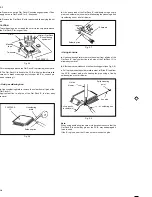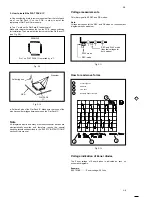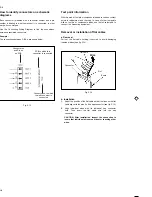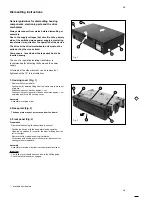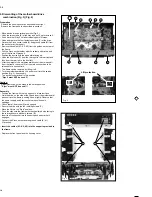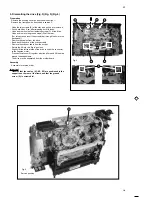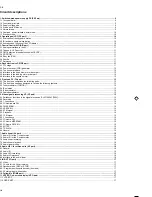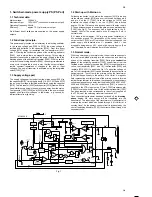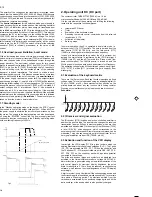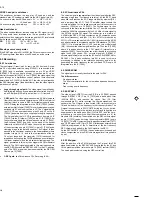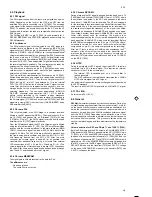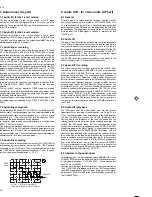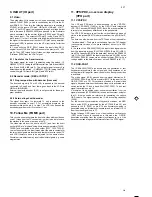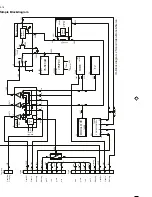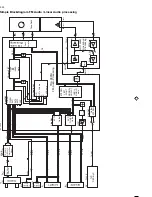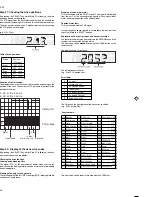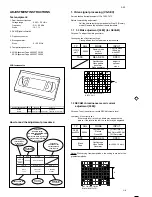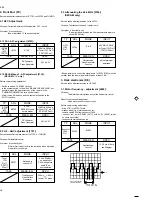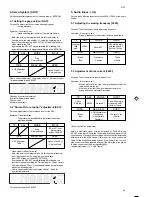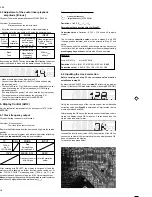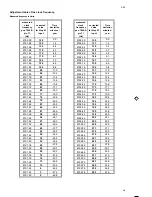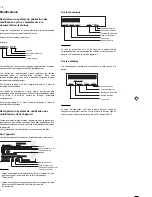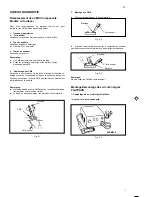
2-16
GB
A: DC, 1 V/Div, 20ms/Div
0V
IC7004-B PIN10 CROT/MTA
71
MTA
MUTE
active
no MUTE
7. Audio linear (AL part)
7.1
Audio
I/O
for the 1-scart version
The input is selected via the IIC bus control in the IC signal
electronics [7004-A]. Either signal AIN1 (pin 76) or AFV (pin 80) is
selected. The output signal AMLP (pin 96) is passed to scart 1 and
to the HF modulator.
7.2
Audio
I/O
for the 2-scart version
The input is selected via the IIC bus control in the IC signal
electronics [7004-A]. Either signal AIN1 (pin 76), AINF_AIN2 (pin
78) or AFV (pin 80) is selected. The output signal AMLP (pin 96) is
always passed to the HF modulator.
7.3 Audio linear recording
The signal inputs for recording or loop-through are pins 76,78 and
80 on the linear audio part of the IC LA71595 [7004-A]. During
record and loop-through, the selected signal passes through the
linear amplifier and then a mute stage and exits the IC on pin 96.
This is the output which leads to the I/O part or the stereo units
back to the AF part. The attenuation chain on pin 96 sets the
required level for the ALC (
A
utomatic
L
evel
C
ontrol) detector and
the level for the recording amplifier. The time constant for the ALC
detector is specified using R3605 and C2602 on pin 77. R3634,
R3640, C2626 and C2627 create the frequency response for the
recording amplifier. The output for the recording amplifier is pin 7.
The recording current is then added to the bias current via resistor
R3642 and flows via the audio head to pin 4 where an electronic
switch is closed in the IC.
In long play mode the frequency characteristic is modified to the
RC network R3635, R3641, C2630, C2631 for the recording
amplifier.
The coil L5600 and the transistor T7608 create the erasing
oscillator for the main eraser head and audio track eraser head,
and generate the bias current for the audio head. The bias current
is set using potentiometer 3625.
To prevent spikes, the erasing oscillator is switched on slowly. This
is created using the switching stage T7603, C2609, R3611 and
R3613.
7.4 Audio linear playback
During playback the switch [T7604, T7607] is controlled by pin 99
and is closed. The playback signal from the head is amplified in the
equaliser stage (time constant between pin 1 and pin 3) and
passed to pin 1. The resistor R3633 and the capacitor C2619
determine the head resonance during playback.
In long play mode the frequency characteristic is modified using
R3627, C2617 for playback.
The output of the playback amplifier (pin 1) is passed via the filter
R3632, C2623 to pin 100 where an electronic potentiometer sets
the playback level via the 12C bus. Amplifier and head tolerances
are compensated here. The amplification can be compensated via
software control (12C bus) in service mode.
7.5 Audio linear muting
The mute stage in the linear audio part on the IC LA71595 [7004-A]
is controlled by the combination control line MTA_CROT which is
connected on pin 10 (VS part). The mute stage is activated in that
the CROT control signal (square-wave pulse 1.7 Vss) is moved
into the upper direct voltage range ( > 2.2 V ).
8. Audio HiFi - for stereo units (AF part)
8.1 General
All audio input and output selection switches, and the hi-fi FM
audio signal processing, are located in the TDA9605 [7650]. This
IC is controlled solely by the IIC bus. The carrier frequencies and
band pass filter for the FM audio part are adjusted by the TDA9605
independently. This adjustment is started via the IIC bus following
a mains reset. The RMHI signal is used as a reference for this
[7650 Pin 41].
8.2 Audio I/O
The input and output selection switches are controlled exclusively
by the IIC bus. Audio signals coming from the receiver part, the two
scart sockets and the front sockets pass via pins 2 to 9 to the two
input selector switches which select the relevant signals for the FM
and the linear audio part. The output selector switch for SCART 1
and SCART 2 (pins 16,17 and 19, 20) select the relevant signal
sources, independently from one another.
The RFAGC limits the maximum amplitude of the signal to the
AMCO modulator (pin 13) to prevent overmodulation.
8.3 Audio HiFi recording
The signal coming from the input selector switch (INPUT SEL)
reaches, via a level actuator (VOLUME L//R) and a low pass filter
(LPF), the NOISE REDUCTION block, which compresses the
dynamics during recording. The compressed signal is passed to
both FM modulators (1.4MHz and 1.8MHz carrier frequencies).
Both carriers are added and pass to the FM audio head amplifier.
Via the recording / playback switch on the head amplifier, which is
switched using the control line RMHI, the FM signal reaches the
output (pin 35, pin 36, pin 37) on the FM audio processor and then
the audio heads via the rotating transformer. The TRIA_ALM line
forwards the size of both audio signals (1 VRMS = 2.68 VDC) to the
AIO processor [7899-B]. This DC level information is required
during recording by the SCART or front cinch socket to prevent
overmodulation of the FM carriers. When the audio signal levels
are too high, they are attenuated using the VOLUME controller via
the I
2
C bus.
8.4 Audio HiFi playback
The FM signal from the audio heads goes via the rotating
transformer to the recording / playback switch (pin 35, pin 36, pin
37) on the head amplifier. After amplification in the head amplifier
(66 dB), the FM signal reaches the HF-AGC (Automatic Gain
Control), where the tolerances of the tape, the heads and the
rotating transformer are balanced. Via the two band pass filter and
limiters, the FM signals reach the PLL demodulators. Head
change-over interference is suppressed using SAMPLE & HOLD
stages (triggered by the RMHI signal). The demodulated signals
are then expanded into the NOISE REDUCTION stage. The hi-fi
signals are then available at the output selection switches. If there
is no audio FM on the tape during playback, the output selector
switch is switched over automatically from the IC to linear audio
(input pin 22). In playback mode the TRIA_ALM line supplies the
level of the FM envelope curve to the AIO processor [IC7899-B].
This level information from the FM envelope curve is used for the
hi-fi tracking of the rotating FM audio heads to achieve the best
possible playback quality (typically: 3.5 VDC).
8.5 Interface to the audio linear
In recording mode, the input selection switch NORMAL SEL in the
TDA9605 [7650] selects the audio source for the linear audio part
in the signal electronics IC LA71595 [7004 - A] and passes this
signal to pin 21 (AMLR).
In stereo sets, the input selection switch on the signal electronics
IC LA71595 [7004-A] is always set to IN2 (pin 78). During playback
the AMLP signal passes from the linear audio part in the signal
electronics IC [7004-A] pin 96 to the linear audio input on pin 22 on
the TDA9605 [7650].
Содержание VTFX940EUKN
Страница 6: ......
Страница 30: ......
Страница 83: ...3 1 3 1 Wiring Diagram Motherboard ...
Страница 85: ...3 3 3 3 Block Diagram Video ...
Страница 87: ...3 5 3 5 Block Diagram Audio Stereo ...
Страница 88: ...3 6 3 6 Supply Voltages and Bus Diagram ...
Страница 91: ...3 9 3 9 Block Diagram Central Control AIO1 AIO2 OPTION ...
Страница 92: ...3 10 3 10 Mother Board solder side CLOCK ADJUST 4769 ...
Страница 93: ...3 11 4769 E10 ...
Страница 94: ...3 12 ...
Страница 119: ...THE UPDATED PARTS LIST FOR THIS MODEL IS AVAILABLE ON ESTA ...
Страница 120: ......

